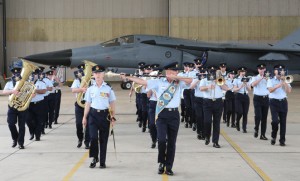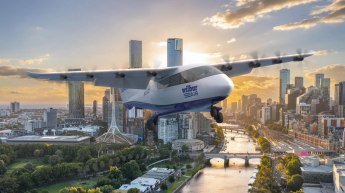
The RAAF retired the F-111 on December 3 after 37 years of service, with a flypast of Ipswich, Brisbane, and the Gold and Sunshine Coasts by six F-111s accompanied by four F/A-18Fs, and a final F-111 singleton display overhead RAAF Amberley, the type’s final flight.
The flights were the culmination of two days’ of retirement celebrations at Amberley (dubbed ‘Pigs Tales’) and a week of flypasts of major and regional towns and cities by 6SQN jets. The last aircraft to land, A8-125, was also the first to land at Amberley on delivery in 1973.
A formal retirement parade hosted by OC 82WG GPCAPT Steve Roberton was held at Amberley on December 2 and was attended by CO 1SQN WGCDR Glen Braz; CO 6SQN WGCDR Micka Gray; Air Commander Australia AVM Mark Skidmore; and Deputy Chief of Air Force AVM Geoffrey Brown, all of whom are former F-111 aircrew, and the parade reviewing officer, Chief of Air Force AIRMSHL Mark Binskin. Also in attendance were many current and former F-111 air and ground crews, and industry support personnel.
The F-111 entered service with the RAAF in 1973 after being ordered in 1963. The aircraft suffered a prolonged grounding caused by early design problems and were placed in storage for five years prior to delivery, but were progressively upgraded with improved sensors, avionics and weapons over their career to keep them at the forefront of technology and capability. The original 24 F-111Cs were supplemented by four ex-USAF F-111As in 1980 and 15 F-111Gs in 1993, for a total of 43 aircraft to have flown in RAAF colours. A further 11 ex-USAF F-111As, Fs and Gs were bought for spares by the RAAF but remained in the AMARG boneyard in Arizona.
Throughout its service life, the F-111 was one of the three tips of the Australia’s strategic spear of deterrence, along with the Oberon and Collins submarines, and the Army’s Special Air Service (SAS) and commando regiments. The decision to retire the aircraft was taken in 2004 as support costs and technological risk as a sole operator were projected to sharply rise after 2010. The USAF had retired its final F-111F strike aircraft in 1996, and its EF-111 Raven electronic warfare aircraft in 1999.
Described as “easy to fly but difficult to operate” by WGCDR Gray, the RAAF lost five crews in crashes involving seven F-111Cs and one F-111G over the years, and these crews were honoured with a memorial service.
The strategic deterrence of the F-111 will in part be replaced by the F/A-18F Super Hornet which is expected to achieve IOC by the end of this year, and JASSM missile-toting F/A-18As supported by KC-30A tankers from 2011.















eNaRGe
says:Bye Pig!!
I’ll miss those dump and burns! Airshows just won’t be the same without it.
Lisa
says:Last time we see the F-111 over Brissie today, lucky for us we saw one very unexpectantly and very close over Lake Moogerah a few weeks ago doing a practice run over the lake, scared the $%#%$ out of the kids LOL, remember once upon a time we took a young lady to riverfire and I she loved it then – good times xxxx
jt
says:Dec 3 – Eureka Stockade… Pigs retire —– important day
Rob
says:A very sad day indeed it won’t be the same with the Hornet. The Pig was such a impressive aircraft only saw a few RAAF ones over in the UK mostly US ones from Upper Heyford/Lakenheath over here. May she rest in peace.
Tony
says:A magnificent piece of machinery, spawned during the Space Race era, who’s abilities STILL exceed it’s “de-facto replacement” in speed/range/payload/and service ceiling, has sadly been laid to rest before a worthy successor has arrived to replace it my country…… We can thank the previous federal government, and their agendas, for having this “Peace Enforcer” retired a few years before it’s time. I hope we don’t regret “Scrapping” them a few years too early.
stoka
says:The F-111 fleet should be upgraded and kept flying. At the very least it should be kept in storage. We are in peacetime and the imperative to maintain this important aircraft seems minimal. In the event that Australia faced imminent military threat, our decision to scrap the F-111 fleet will return to haunt us.
The F-111 could be upgraded with contemporary engines and avionics for a fraction of the cost of new aircraft, and it has capabilities which simply do not exist in any other plane; capabilities which make it invaluable in a country the size of Australia.
Peter
says:Stoka – I totally agree about the F-111 fleet should be kept flying & upgraded. Check on the APA website for more information about Why Australia should retain its F-111 fleet etc. Indeed it’s totally unacceptable for Australia to retire the magnificant aircraft. If I was a Minister of Defence I will certainely keep the F-111s flying and updated & retire them in 2020 or 2025. Its exactly correct, there’s no other aircraft in the world (e.g. F/A-18E/F Super Hornet, F-16 Fighting Falcon, Dassault Rafale, Eurofighter Typhoon & F-35 JSF) that can replace the F-111 in the strike role. Except the F-15E variants or the Silent Eagle which is the best plane to replace our Classic Hornets.
The F-111 is a contemporary of the US B-52H and B-1B bombers, both of which the US Air Force intends to operate well past 2030.
andrew
says:will the f35 be as good Australia is a big country.